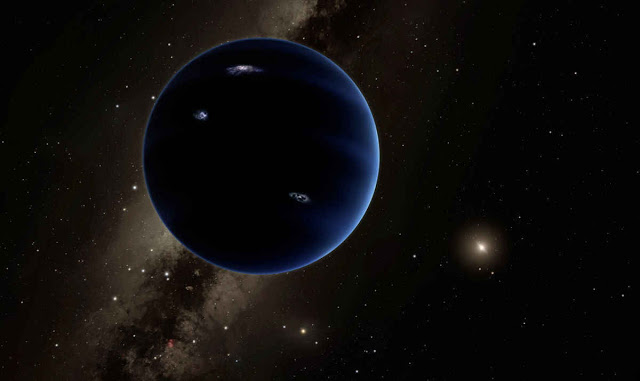The researchers have found evidence of a giant planet tracing a bizarre, highly elongated orbit in the outer solar system. The object, which the researchers have nicknamed Planet Nine, has a mass about 10 times that of Earth and orbits about 20 times farther from the sun on average than does Neptune (which orbits the sun at an average distance of 2.8 billion miles). In fact, it would take this new planet between 10,000 and 20,000 years to make just one full orbit around the sun.
“I’m pretty sure, I think, that by the end of next winter — not this winter, next winter — I think that there’ll be enough people looking for it that … somebody’s actually going to track this down,” Brown said during a news conference Wednesday (Oct. 19) at a joint meeting of the American Astronomical Society’s Division for Planetary Sciences (DPS) and the European Planetary Science Congress (EPSC) in Pasadena, California. Brown said that eight to 10 groups are currently looking for the planet
Artist’s illustration of Planet Nine, a world about 10 times more massive than Earth that may lie undiscovered in the outer solar system.
Credit: Caltech/R. Hurt (IPAC)
The evidence for Planet Nine’s existence has continued to grow over the past nine months, as several different research teams have determined that the orbits of other small, distant objects appear to have been sculpted as well.
One team, led by Renu Malhotra of the University of Arizona, discussed four such objects at the DPS/EPSC meeting Wednesday. And Brown’s team, led by Elizabeth Bailey of Caltech, announced at the meeting on Tuesday (Oct. 18) that Planet Nine appears to have tilted the orbits of all eight “official” planets by 6 degrees relative to the sun.
Astronomers have said Planet Nine is perhaps four times wider than Earth, and such an object would be easily visible with professional-grade equipment if it were relatively close to Earth, Brown explained. In addition, planets on highly elliptical orbits spend most of their time near aphelion, since they’re traveling most slowly on this part of their path, he said.
An object four times bigger than Earth that’s located at 1,000 AU would have a magnitude of about +25 on astronomers’ brightness scale, Brown added.
“This is well within reach of the giant telescopes,” he said. “The Subaru telescope, I think, on Mauna Kea, [in Hawaii] — the Japanese national telescope — is the prime instrument for doing the search. But there are a lot of other people who have clever ideas on how to find it, too, that are trying with their own telescopes.”
SOURCES- Caltech, Space.com

Brian Wang is a Futurist Thought Leader and a popular Science blogger with 1 million readers per month. His blog Nextbigfuture.com is ranked #1 Science News Blog. It covers many disruptive technology and trends including Space, Robotics, Artificial Intelligence, Medicine, Anti-aging Biotechnology, and Nanotechnology.
Known for identifying cutting edge technologies, he is currently a Co-Founder of a startup and fundraiser for high potential early-stage companies. He is the Head of Research for Allocations for deep technology investments and an Angel Investor at Space Angels.
A frequent speaker at corporations, he has been a TEDx speaker, a Singularity University speaker and guest at numerous interviews for radio and podcasts. He is open to public speaking and advising engagements.


